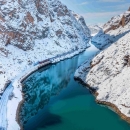

Benefits of 1st Class Train Travel in Europe
I boarded the first-class carriage of Switzerland’s famous Glacier Express ―possibly the most luxurious scenic train in Europe― and instantly felt out of sorts.
One month of travel had not been kind on my Converses ― they were battered and caked in a layer of mud courtesy of the Italian Alps, as was my once-red backpack that had been through the wringer.
My jeans had ripped at the knee a few weeks earlier somewhere in France, and I had stopped caring too much about combing my hair.
I found a seat two away from a man in a crisp navy golf shirt and a fedora, and a woman dressed entirely in white except for her dark glasses. As I sat down, he subtly nudged her. They exchanged a few hushed words, and when the conductor walked the carpeted aisles, I’m pretty sure they adjusted their seats to get a good view of my imminent ejection.
But it never happened, because clenched in my fist was a Global Pass, with which I was cruising my way across the continent.

After the conductor left I met the couples’ eyes, smiled smugly, and then shifted my focus to the scenic spectacle unfolding outside. When the waiters arrived to lay the table in front of me, with starched tablecloths, silver cutlery and actual glasses, I felt like I was living the lifestyle of the rich and famous.
Although on most trains you will ride in Europe, there is not likely to be a huge difference between first and second class, there are some that can create lasting memories, improve your experience, or just slightly increase your comfort.
7 reasons why it's worth paying extra for your 1st class train pass:
1. Increased leg room and seat width
Your seat is possibly the most important comfort factor while on board a train, and when it comes to regional trains in Europe, most are created equal ― that is to say, not lounge-recliner comfortable, but usually perfectly acceptable for a few hours of overland travel.
Some trains, however, throw in a few extra centimetres for first class travellers on both the seat width and leg room that can make all the difference. Some trains also configure the aisles to make them slightly wider, usually making the experience less cramped.
2. Superior comfort
Some trains take first class comfort further than a few added centimetres. Most first class seats now have plug points for each passenger, wider tables, more generous luggage racks, and, increasingly, free wifi.

First class in Switzerland’s scenic trains, for example, also often offer leather seats, carpeted aisles, and at-seat service. If you are travelling through Austria, and willing to pay in a little extra on top of your Plus Pass when aboard a RailJet train, you can recline in a lavish business class seat that more closely resembles a living room sofa than a typical train seat. On some routes they will even throw in a cold beer delivered and poured at your seat. Although these are the exceptions rather than the norm, they are worth looking out for while planning your journeys.
3. Peace and quiet
The social factor is one of the biggest reasons to travel by train. The relaxed nature of second class means it is easy to strike up a conversation with fellow travellers, and alight with a handful of new Facebook friends and Instagram followers.

First class can be slightly different, however. Most people in Europe’s first class train carriages are travelling for business, or are on someone else’s dime, so they are less into the small talk and more into their laptops. Because of the price of these point-to-point tickets, the carriages are also often less crowded, allowing you more room to spread out and relax, and the general peace and quiet of these carriages can be surprisingly welcome after a few weeks of intense travel.
4. Finding a seat
Second class point-to-point tickets can cost up to 30% less than first class tickets, and at peak times or on popular routes this can often mean finding a seat is difficult. First class is seldom full, and it is usually much easier to find a seat. This is also a factor to consider if you want to bag a specific seat, like by the window or at a table.
5. Ordering in
Many first class carriages in high speed trains across Europe offer some kind of on-board meal served at your seat, often at no extra cost. Depending on the route this can be as simple as crackers and a coffee, but on certain trains such as the Eurostar, it can be a full meal.

Some of the continent’s famous scenic trains have onboard waiters who will attend to you at your seat, and although meals usually cost extra, they are worth trying at least once for a truly unique dining experience.
6. Seamless arrivals and departures
Much like first class on airplanes, many trains are configured to make it very clear that those able to afford this luxury are prioritized. This often means that first class carriages on the longer high-speed trains, such as the Eurostar, arrive in the station closest to the exit ― perfect for saving a few minutes if you are in a rush. Some of these trains also offer priority boarding to first class and business premier ticket holders.

7. First class lounges
Your first class Pass will give you access to first class lounges on the day of your departure at many stations in Europe with these facilities. Some of these lounges go as far as to offer free food, drinks (sometimes including alcohol), newspapers, comfortable reclining seats, baggage storage, and wifi. This is a particularly useful benefit if you have a long wait before your connecting train.
You may like this as well
-
![Scenic-view-window-moving-train]() 7 types of Pass benefits you'll love Want the ultimate train ticket to explore Europe? Interrail is so much more than a flexible rail pass; it's also packed with tons of freebies and discounts.
7 types of Pass benefits you'll love Want the ultimate train ticket to explore Europe? Interrail is so much more than a flexible rail pass; it's also packed with tons of freebies and discounts. -
![first- class-train-masthead]() Benefits of 1st Class Train Travel in Europe Want to know if paying more for first-class train travel in Europe is worth it? Here are some benefits of travelling by rail with a 1st class Global Pass.
Benefits of 1st Class Train Travel in Europe Want to know if paying more for first-class train travel in Europe is worth it? Here are some benefits of travelling by rail with a 1st class Global Pass.
Change of currency
You cannot change the currency once you have a Pass in your cart. Remove the Pass, and then change the currency on the website header.







